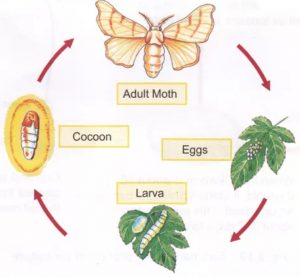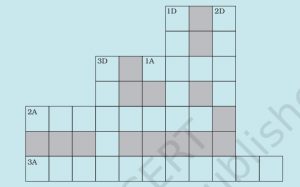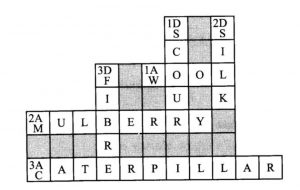NCERT Solutions for Chapter 3 Fibre to Fabric for Class 7
Question 1. You must be familiar with the following nursery rhymes:
(i) ‘Baa baa black sheep, have you any wool.’
(ii) ‘Mary had a little lamb, whose fleece was white as snow.’
Answer the following:
(a) Which parts of the black sheep have wool?
(b) What is meant by the white fleece of the lamb?
Answer
a) The fine and soft hair that grows at the back of the sheep have wool.
b) It means the colour of the fleece of lamb is white.The natural fleece of sheep is black, brown or white.
Question 2. The silkworm is (a) a caterpillar, (b) a larva.
Choose the correct option. (i) a (ii) b (iii) both a and b (iv) neither a nor b.
Answer (iii) both a and b
Question 3. Which of the following does not yield wool? (i) Yak (ii) Camel (iii) Goat (iv) Woolly dog
Answer (iv) Woolly dog
Question 4.What is meant by the following terms? (i) Rearing (ii) Shearing (iii) Sericulture
Answer Rearing: It is a process of breeding, feeding and providing medical care to useful animals. These animals are feeded, given shelters and breeded for better yields.
Shearing: When a thick coat of hair, is shaved off from sheep to obtain wool. The process of cutting off the woollen fleece of sheep with a thin layer of skin is called shearing.
Sericulture: It is the rearing of silkworms to obtain silk.
Question 5. Given below is a sequence of steps in the processing of wool. Which are the missing steps?
Add them. Shearing, __________, sorting, __________, __________, _________.
Answer Shearing, scouring, sorting, fibre spinning, fibre drying, rolling in silk yarn.
Question 6. Make sketches of the two stages in the life history of the silk moth which are directly related to the production of silk.
Answer 6
Question 7. Out of the following, which are the two terms related to silk production? Sericulture, floriculture, moriculture, apiculture and silviculture.
Hints: (i) Silk production involves cultivation of mulberry leaves and rearing silkworms.
(ii) Scientific name of mulberry is Morus alba
Answer 7 Sericulture and moriculture.
Question 8. Match the words of Column I with those given in Column II:
Column I Column II
1. Scouring (a) Yields silk fibres
2. Mulberry leaves (b) Wool yielding animal
3. Yak (c) Food of silk worm
4. Cocoon (d) Reeling
(e) Cleaning sheared skin
Answer 8
Column I Column II
1. Scouring (e) Cleaning sheared skin
2. Mulberry leaves (c) Food of silk worm
3. Yak (b) Wool yielding animal
4. Cocoon (a) Yields silk fibres
Question 9. Given below is a crossword puzzle based on this lesson. Use hints to fill in the blank spaces with letters that complete the words.
Down Across
(D) 1 : Thorough washing (A) 1 : Keeps warm
2 : Animal fibre 2 : Its leaves are eaten by silkworms
3 : Long thread like structure 3 : Hatches from egg of moth
Answer 9



Leave a Reply